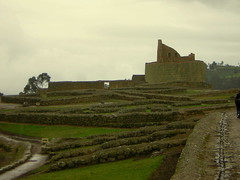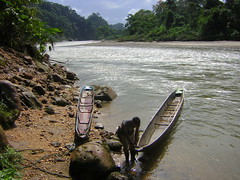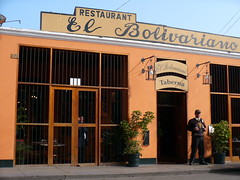Moche: Huaca del Sol y Huaca de la Luna
In the heart of their world, the Moche constructed two truncated pyramids, the gigantic pyramid of the Sun (sol) and the smaller pyramid of the Moon (luna). These pyramids, and the city that spanned between them functioned as their capital.
The Huaca del Sol is by far the largest of the two and is one of two pyramids in Peru thought to possibly be the largest adobe mud-brick construction in the Americas. It functioned as a political-administrative centre. It is thought to have once been 43 metres high with a base that was 228×136 metres in size. Unfortunately this pyramid has been heavily damaged. Rather that looting the pyramid by hand, digging through the 130,000,000 mud bricks it took to construct, in order to find gold, the Spanish decided they’d divert the nearby river to wash the pyramid away and catch any gold being washed out. The Huaca del Sol now sits mostly destroyed, waiting for funds to begin restoration, excavation and investigation.
The Huaca de la Luna is the smaller of the two, but work has been carried out on it that has uncovered some amazing things. For me, this pyramid that functioned as the religious, ceremonial and sacrificial centre of the Moche, was probably the most interesting archaeological site I have seen in Peru. I couldn’t possibly have imagined that any mud construction could be so breath-taking.
Temples in the Huaca de la Luna were superimposed over each other over different periods of Moche civilisation, in this way the pyramid continued to grow. The base is 87m2 and 21m high.
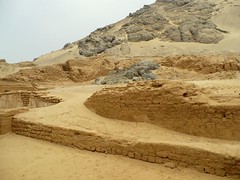 |
Sacrifice was an important part of the Moche culture (described here), and lots of sacrifice took place here. Backed onto a nearby rocky-peak (Cerro Blanco or White Hill), the pyramid has a rocky outcrop of rock that pokes out of the sand. It was here that the Moche killed their prisoners as a sacrifice to the mountains to continue bringing rain to the valley from the Andes. Archaeologists discovered here the remains of as many as 40 male corpses here, presumably killed by being thrown down onto the rock. |
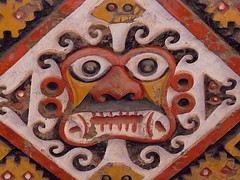 |
Ai-Apaec was the primary god of the Moche, sometimes referred to a the Great Decapitator. Inside the pyramid, with the newer outer layers of the pyramid pealed back, with see dozens of these beautiful images. Some depict different emotions – happiness, sadness or anger.  |
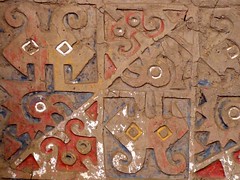 |
The Moche plastered the walls of their pyramids with their distinctive art. In this image try to make out the animals it depicts. Entire lengths of walls were decorated:
|
 |
The main ceremonial area of the temple was beautifully decorated. There are several layers of images on these walls, each distinctive of specific periods of time. Priests would stand hear giving sermons to the groups the gathered at the base of the pyramid. This pulpit is on the top of the pyramid. |
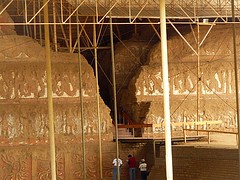 |
This stepped-pyramid is huge, each step higher than a person. When I exited through this tear created by the Spanish I was awestruck. This entire face of the pyramid is preserved and it takes no great amount of imagination to see how spectacular the whole thing would have looked in Moche times. Inside the tear you can see the layer of the temple that came before. |
I strongly urge you to see the large versions of these photos, bellow.
Tags: huaca, huaca de la luna, huaca del sol, moche, pyramids, ruins, trujillo





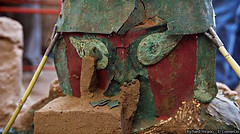
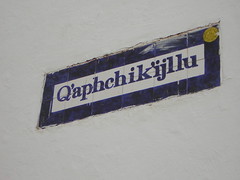


![Andean women’s football championships [Featured]](http://farm4.static.flickr.com/3123/2686374230_4b1aac1b08_m.jpg)
